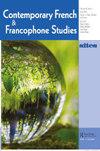种族化女性的著作:走向反种族主义解读
IF 0.2
4区 文学
0 LITERATURE, ROMANCE
引用次数: 0
摘要
摘要本文考察了黑人女性和/或种族化创作者用法语创作的三篇文本:Isabelle Boni-Claverie的《黑色的Trop noire pour être franaise》(2017)、Aminata Aidara的《我很孤独》(2018)和gisnaire Pineau的《椅子》(2002)。这些文本共同探讨了法语中存在的历史和当代形式的种族主义和性别歧视,并寻求将被殖民法国白人至上主义所诋毁的角色的经历人性化的方法。关键词:反种族主义文学写作礼貌化女性法语写作法国白人伊莎贝尔·博尼-克拉维里阿米娜塔·艾达拉·is本文章由计算机程序翻译,如有差异,请以英文原文为准。
Écritures de femmes racialisées : Vers une lecture antiraciste
AbstractThis article examines three texts written by Black women and/or racialized creators writing in French: Trop noire pour être française (2017) by Isabelle Boni-Claverie, Je suis quelqu’un (2018) by Aminata Aidara and Chair Piment (2002) by Gisèle Pineau. Together, these texts interrogate historical and contemporary forms of racism and sexism embedded in the French language and search for ways to humanize the experience of characters generally denigrated by colonizing French white supremacy.Keywords: Antiracist literary writingracialized women writing in FrenchFrench whitenessIsabelle Boni-ClaverieAminata AidaraGisèle Pineau Notes1 https://www.legifrance.gouv.fr/loda/article_lc/LEGIARTI000037090124/2019-03-182 https://www.sbctc.edu/resources/documents/colleges-staff/programs-services/administrators-of-color/central-frames-colorblind-racism-sum2019.pdfAdditional informationNotes on contributorsFrédérique ChevillotFrédérique Chevillot is Professor at the University of Denver. Her research focuses on contemporary novels and short stories by women authors writing in French. She is the author of La Réouverture du texte (Anma Libri), and, co-edited with Anna Norris, Des Femmes écrivent la guerre (Complicités, 2007). She is co-editor of Rebelles et criminelles chez les écrivaines d’expression française, a volume on literary representations of rebellious and criminal women by female authors (Rodopi, 2013). She also collaborated with Elizabeth Hall, Eilene Hoft-March, and Maribel Peñalver Vicea, on an editorial volume titled Cixous After 2000/Cixous depuis 2000, published with Rodopi/Brill (2017).
求助全文
通过发布文献求助,成功后即可免费获取论文全文。
去求助
来源期刊

Contemporary French and Francophone Studies
LITERATURE, ROMANCE-
CiteScore
0.30
自引率
0.00%
发文量
43
期刊介绍:
An established journal of reference inviting all critical approaches on the latest debates and issues in the field, Contemporary French & Francophone Studies (formerly known as SITES) provides a forum not only for academics, but for novelists, poets, artists, journalists, and filmmakers as well. In addition to its focus on French and Francophone studies, one of the journal"s primary objectives is to reflect the interdisciplinary direction taken by the field and by the humanities and the arts in general. CF&FS is published five times per year, with four issues devoted to particular themes, and a fifth issue, “The Open Issue” welcoming non-thematic contributions.
 求助内容:
求助内容: 应助结果提醒方式:
应助结果提醒方式:


